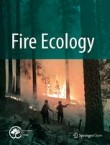Fire Ecology is the official journal of the Association for Fire Ecology.
Modeling fuel break effectiveness in southern Spain wildfires
Fuel breaks aim to reduce the energetic progression of a wildfire, facilitating safe and efficient suppression. Changes in fire regimes are creating increasingly complex scenarios in which a higher percentage ...


